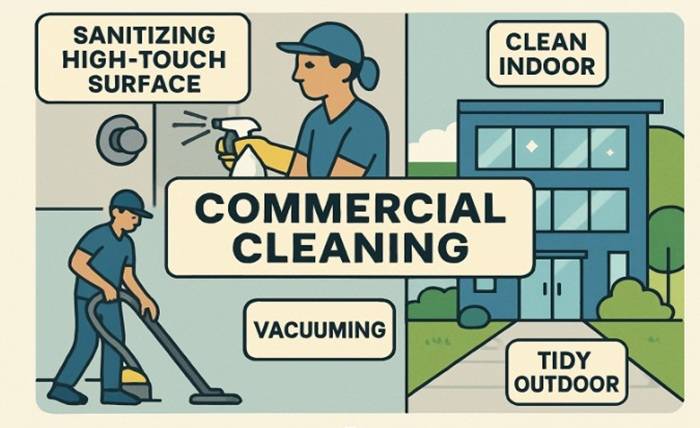Maintaining a clean and healthy commercial environment is essential for businesses seeking to protect the well-being of their employees, clients, and guests. Thoughtful cleaning and maintenance strategies promote not only health but also extend the lifespan of building assets, providing a pleasant and productive atmosphere for everyone. To consistently achieve high standards, many businesses turn to a professional commercial cleaning company with the expertise to handle both routine tasks and specialized needs.
With growing awareness of public health and workplace productivity, it’s never been more essential to implement a facility strategy focused on cleanliness, safety, and proactive management. This includes regular system upkeep, daily sanitation, innovative waste management, and technology adoption, among other vital steps. By systematically incorporating these measures, commercial spaces can remain inviting and hygienic throughout the year.
Regular HVAC Maintenance
The HVAC system is the heart of a commercial facility’s indoor air quality. When air filters become clogged or ducts accumulate dust, air circulation declines and potential health risks rise. All building managers should prioritize scheduled maintenance to reduce airborne allergens and keep spaces comfortable:
- Replace air filters as recommended, typically every 1-3 months, depending on the system’s use.
- Book bi-annual inspections with certified professionals to identify and fix wear or malfunctions before they worsen.
- Periodically clean ductwork to remove built-up mold and dust, further diminishing allergy triggers and respiratory hazards.
Leveraging HVAC best practices not only prevents disruptions and increases system longevity but also helps maintain regulatory compliance for indoor air quality. For more information on HVAC health and safety requirements, refer to established authorities such as the EPA’s Indoor Air Quality resource.
Daily Cleaning of High-Touch Surfaces
Everyday objects such as doorknobs, elevator buttons, desktops, and shared electronics can quickly become reservoirs for germs. To minimize transmission risks among staff and visitors, all high-traffic touch points should be disinfected multiple times per day during operating hours:
- Deploy EPA-approved disinfectants and ensure janitorial teams are trained for high-frequency sanitizing of communal objects.
- Encourage employees to clean their workstations and personal devices with suitable wipes on a regular basis.
- Place hand sanitizing stations throughout high-traffic areas to prompt frequent use by everyone on-site.
Strict adherence to cleaning protocols reinforces employee and client confidence in workplace safety, supporting business continuity.
Effective Waste Management and Pest Control
Improper waste handling and delayed pest intervention can swiftly erode workplace health. Overflowing bins are attractive to rodents and insects, creating unsanitary conditions. A robust plan should include:
- Implement a regular, scheduled collection program tailored to the facility’s size and traffic volume.
- Use lined, covered bins and clean them out at least once per week to reduce odors.
- Scheduling regular pest assessments and acting immediately on any findings to prevent escalation.
Prevention matters as much as response—by tackling the root causes of pest infestations and maintaining strict waste policies, facilities protect both employees and brand reputation.
Maintaining Outdoor Areas
First impressions start before anyone walks through the door. Well-maintained sidewalks, parking areas, and landscaping not only enhance curb appeal but also protect visitors from common hazards such as slips and trips. Responsible facility upkeep should involve:
- Clearing all outside walkways of debris, snow, or leaves, and ensuring adequate lighting is provided after sunset.
- Routinely trimming greenery, mowing lawns, and mulching to keep grounds neat and free of pest harborage.
- Inspecting fixtures like benches, railings, and business signage; repair or replace damaged items immediately to avoid accidents or visual decline.
Ongoing attention to outdoor maintenance supports a holistic approach to safety and property value. For more tips on enhancing commercial curb appeal, browse resources from leaders like Total Landscape Care.
Implementing Smart Maintenance Technologies
Modern facility managers leverage innovative technology to automate and optimize everything from climate control to leak detection, creating safer spaces while containing costs. Key considerations include:
- Installing programmable thermostats for efficient heating and cooling aligned with occupancy hours.
- Deploying water leak sensors to intercept plumbing issues before they cause significant damage.
- Using motion-sensor lighting systems in infrequently used corridors or restrooms to save energy and deter unauthorized access.
The adoption of such technologies not only streamlines daily operations but also enables predictive maintenance and real-time alerts, thereby minimizing costly breakdowns and environmental impact.
Regular Deep Cleaning Services
Beyond the scope of daily cleanups, deeper sanitation is essential for spaces like restrooms, lunchrooms, and meeting areas that gather grime and bacteria over time. Deep cleaning involves thorough:
- Disinfection of all vertical and horizontal surfaces, not just obvious gathering points.
- Pay special attention to ventilation systems, carpets, tile grout, and areas behind large appliances or furniture, where dust and spills tend to accumulate.
- Utilize commercial-grade cleaning products and equipment to ensure every corner is thoroughly addressed.
Comprehensive sanitation programs are critical for preventing outbreaks and maintaining compliance with local health regulations.
Encouraging Personal Hygiene Practices
Individual behavior is a crucial defense against workplace illness. Robust education campaigns and readily accessible hygiene supplies foster a sense of collective responsibility among staff and visitors. Recommendations include:
- Equipping every restroom and kitchen area with soap, paper towels, and signage explaining effective handwashing techniques.
- Providing touch-free sanitizer dispensers at entries and communal gathering points, including conference rooms and break areas.
- Incorporating reminders and workshops on respiratory etiquette (such as proper mask use and cough covering techniques) within onboarding and staff meetings.
Championing personal hygiene not only limits the spread of infectious diseases but also fosters an influential culture of mutual care and organizational pride.
Conclusion
The task of maintaining healthy commercial spaces extends beyond basic cleanliness to encompass strategic, tech-enabled, and people-centered solutions. By combining regular system maintenance, thorough daily and deep cleaning routines, integrated waste and pest management, and a proactive approach to outdoor and personal hygiene, businesses can bolster productivity and safeguard the health of all who enter their premises. For further guidance on best-in-class facility standards, consult the EPA’s recommendations on building ventilation and safety.

